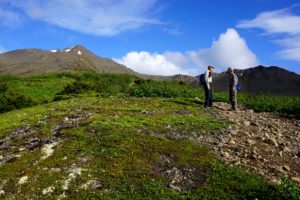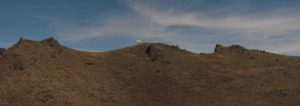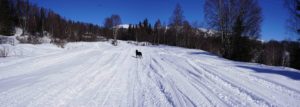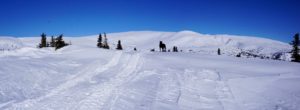
Cloud shadows in Grubstake Gulch
The landscape shifted constantly, as fast as minute to minute, and even moment to moment. One moment the ridge spread out from my feet in a glow of green tundra. The next moment it lay under a veil of gray shadow. And as the earth shifted, so did the sky shift. One only had to look around to see its many moods. Directly overhead moved billowing white clouds. To the southeast loomed two high, charcoal thunderclouds. Seven miles to the east rain fell in gray sheets over Government Peak. Twenty-five miles to the west sunlight filled the length of the Susitna River valley. Fifty miles to the west, though, banks of slate clouds hid the closest summits of the Alaska Range. Nor to the south could one see Anchorage or Cook Inlet for the curtain of washed lead that dropped in the way.

Lingering snow from a spring avalanche
As so many philosophers going all the way back to Heraclitus have told us again and again things change continuously. One does not often witness it so graphically, though. On a hike or climb the weather usually stays relatively constant: If you start out under a cloudy day it usually remains a cloudy day. If you start out on a sunny day it usually remains a sunny day. If either day changes it usually does so once, with clouds dispersing to sunshine or sunshine disappearing behind clouds. Thus a day can change, thus, in turn, changing the mountains.
We also see mountains change from season to season. Buried under snow and ice in winter, carpeted in green in the summer, and cloaked in yellow in the fall. We also know they change over larger spans of time, rising with the shifting of continents and falling in long slow periods of erosion. We know they change due to the lashing of water and wind and the pushing and pulling of glaciers and earthquakes.

Fair weather clouds moving over Bald Mountain Ridge
We know all that but this change occurred almost too quickly, an all too immediate reminder of time passing. The changes on Bald Mountain Ridge (the long ridge just north of Wasilla) occurred rapidly with the light coming and going and the wind rising and falling in the shifting light. And it occurred over many hours.

Thunderheads over Matanuska Peak (on the left) and Pioneer Peak (on the right) with Knik Glacier in between
And as the light and wind came and went, so did the mountains appear to change beneath them. Off to the northeast two towering thunderclouds framed the darkened snout of Knik Glacier. To the south another long line of heavy clouds hung over the brim of the Chugach Mountains. To the north rank after rank of billowing cumulus clouds extended over the Talkeetna Mountains, their shadows rolling over ridges and summits as they moved. Though brought about by the mere movement of light and wind, such sights created both an exhilarating and disconcerting mood as the hours passed and the views came and went.
Most people would agree that the appearance of permanence, the illusion created by slow change, makes one comfortable. Few like their schedules or routines changed or disrupted. Changing shifts, starting new semesters, moving to a new city all nudge us off-center to varying degrees. Then time passes and we adjust to a new schedule or routine. Things once more take on the appearance of permanence.

The ridge leading north to Hatcher Pass
Thus the rapid changes occurring around me on the ridge did not change or disrupt the hike as much as my sense of it. Moving through a world in seemingly too much flux made it seem like one should hurry a little bit and linger a bit less. Yet no reason dictated the need to heed this small tug of urgency. Though the day had already begun to wax toward evening when I reached the first summit of Bald Mountain after climbing up from Hatcher Pass Road, enough light would stay to hike all night. In addition, I could see my entire 14-mile route around the rim of Grubstake Gulch.

Looking south across Palmer Hay Flats to torm clouds over the Chugach Mountains
But as I moved along the ridge the changes around me began to slow. The winds stilled and the clouds dispersed, making the day seem calmer, slower. And as the day slowed, I slowed, feeling less need for hurry.
As I turned around the upper corner of the gulch and began rising toward the last and highest summit, the terrain turned more rugged. Some short gullies and narrow ledges needed the use of hands to climb. The last few hundred feet to the summit, though, proved a gentle walk up a broad slope.

The highest point on the ridge
As the long shadows of night began to fill the valleys I paused on the summit for a few moments in to look at the low light glancing off mountains and ridges. Then I started my descent into the darkening upper end of the gulch. After a 500-foot descent I dropped down an embankment onto an old mining roads climbing high into the valley.

Finally back on a trail (mining road) in Grubstake Gulch
That left but a 3-mile hike under a now clear sky to reach the car. The road took me along two old deserted mines. They too have changed: once places of noisy activity, they now stood as silent reminders of days of yore when people climbed into these hills searching gold and not adventure. Now only the sound of the creek 200 feet down to the right filled this valley with noise.
As I neared the bridge across Willow Creek, a grouse jumped out to lead me away from her chicks hidden in the brush.
“Don’t worry, mom, I won’t bother your kids.”

Self-portrait on the descent into Grubstake Gulch
But she kept zigzagging down the trail with wings extended and beak a-squawking. When she finally veered off the trail, giving me one last squawk, there again remained only the sound of the stream and my shoes shuffling down the road.
After my passing only the sound of the stream would remain—the only apparent constant in this world of change, at least constant for the remainder of the night before a new day brought new changes to the ridges and mountains rising toward the changing sky above.













 On one of the last, long days of spring the evening light splashed over the ridges and valleys as the winds above south Anchorage hurried the clouds above. Beneath those clouds a long line of hikers weaved their way up the west ridge of McHugh Peak.
On one of the last, long days of spring the evening light splashed over the ridges and valleys as the winds above south Anchorage hurried the clouds above. Beneath those clouds a long line of hikers weaved their way up the west ridge of McHugh Peak. At 6 pm, the usual departure time for all Tuesday-evening hikes, the group began filing up the trail. Before long the group of some 20-plus hikers, along with numerous dogs, formed a long line along the trail. Some moved small clusters of four or five hikers. Others moved up the mountain in singles or pairs. Once above tree line one could see this long colorful bead of hikers stretching up the ridge as the wind moved the light across the landscape about them.
At 6 pm, the usual departure time for all Tuesday-evening hikes, the group began filing up the trail. Before long the group of some 20-plus hikers, along with numerous dogs, formed a long line along the trail. Some moved small clusters of four or five hikers. Others moved up the mountain in singles or pairs. Once above tree line one could see this long colorful bead of hikers stretching up the ridge as the wind moved the light across the landscape about them. As the first “sisters” returned to the house, they settled into the annual barbecue capping off this annul hike. As people ate, the beer and wine ran freely while dogs looked on longingly. Those lucky enough to wander off-leash even managed to scrounge some tidbits.
As the first “sisters” returned to the house, they settled into the annual barbecue capping off this annul hike. As people ate, the beer and wine ran freely while dogs looked on longingly. Those lucky enough to wander off-leash even managed to scrounge some tidbits. Near 10 pm the last three hikers, some of the few that had actually climbed the near 2,500 feet up the ridge and across the plateau beyond to the summit (4,301 feet), join the party.
Near 10 pm the last three hikers, some of the few that had actually climbed the near 2,500 feet up the ridge and across the plateau beyond to the summit (4,301 feet), join the party.













